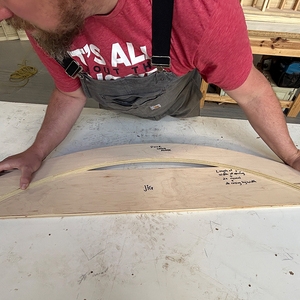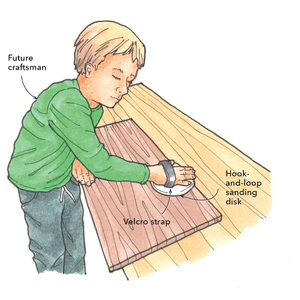Help! I’m trying to figure out how to mitre the corner. I have to install a chair rail/ cap mldg over some wainscoting that is on a wall that leads up a staircase. The problem is where the level piece has to ty into the piece that follows the slope of the staircase. The piece that follows the slope ends up to long across the mitre. I was told this is a intersecting mitre. How do I cut this joint or should I make mldgs of different widths?
Discussion Forum
Discussion Forum
Up Next
Video Shorts
Featured Story

Listeners write in about air-sealing numbers and wildfire recovery, before asking questions about replacing a row house roof and what kind of roof insulation is needed.
Featured Video
Builder’s Advocate: An Interview With ViewrailHighlights
"I have learned so much thanks to the searchable articles on the FHB website. I can confidently say that I expect to be a life-long subscriber." - M.K.
Fine Homebuilding Magazine
- Home Group
- Antique Trader
- Arts & Crafts Homes
- Bank Note Reporter
- Cabin Life
- Cuisine at Home
- Fine Gardening
- Fine Woodworking
- Green Building Advisor
- Garden Gate
- Horticulture
- Keep Craft Alive
- Log Home Living
- Military Trader/Vehicles
- Numismatic News
- Numismaster
- Old Cars Weekly
- Old House Journal
- Period Homes
- Popular Woodworking
- Script
- ShopNotes
- Sports Collectors Digest
- Threads
- Timber Home Living
- Traditional Building
- Woodsmith
- World Coin News
- Writer's Digest


















Replies
The current issue of FHB describes how to take crown molding around the corner in a room with a cathedral ceiling - it sounds very similar to what you're doing. You might want to check it out - no way I could describe it - they have good pix. Bill.
Check this out and also, look in the letters section of the current FHB for gary katz's letter "a safer jig for acute angles on the miter saw" and be careful when you try these methods.
http://forums.taunton.com/n/mb/message.asp?webtag=tp-breaktime&msg=40988.1
Remodeling Contractor just outside the Glass City.
Quittin' Time
Edited 3/23/2004 11:57 am ET by calvin
If the point at which the level piece meets the sloped piece is also at a corner, then read the current issue of FHB, as mentioned. (And we'll all pray for you -- that is a confusing process.)
But if there is no corner involved, then all you need to do is miter both pieces.
The cut-angle for that miter will be half of the intersecting angle. For example, if the two pieces of trim intersect at a 120 degree angle, then the end of each piece must be cut at a 60 degree angle.
To determine the intersection angle, you can use a school-style protractor if you don't have a sliding bevel guage.
Unless you're the lead dog, the view just never changes.
If you are taking this chairrail around a corner, and at the corner want to take it up or down some stairs, you cannot make the corner miter and stairslope transition together, at the corner.
Make the corner first, with a simple 45 miter, then run out over the stairs for a few inches, then make your stair miter. Mitered cuts will then match in profile.
draw a level line .... for the level cap.
then a pitched line ... matching the stairs ... for the up the steps cap.
make them intersect ...
hold a scrap piece on top of the level line ... run a pencil along the top.
hold the scrap on the pitched line ... mark the top again.
Now those should intersect too ...
hold that test piece between the two level lines ya now have ...
there should be a pitched line coming down the wall ...
That'll tell ya where the top and bottom of the piece are to be marked.
Make those dots ...
connect those dots ...
who cares what the exact angle is ...
just line up the chop saw blade with that pencil line ....
there's your angle.
repeat for a test piece along the pitched lines ....
/ /
______/_ _ _ /_ _ _
/ /
____/____/_ _ _ _ _
Kinda like that , but that would be some pretty steep stairs ....
... maybe I can stary using those keys to draw prints?
Jeff
Buck Construction Pittsburgh,PA
Artistry in Carpentry
and ... the agnle running up the stairs can be attained as easily as taking a measurement from the tip of each step ... top and bottom .. and snapping a line.
Do some test measurements to check ... but should work.
JeffBuck Construction Pittsburgh,PA
Artistry in Carpentry
One solution is to not do the match-up at the corner, but rather to wrap the corner with the horizontal, then make a transition to the slant. To make the transition you cut each end at half the angle between them. (Ie, if the trim is going to slant upward at 30 degrees, you make a cut that's 15 degrees off a 90.)
If you have to bring the slant all the way to the corner, probably your best solution is to use some form of corner block.
I have looked for this article in march2004 issue and am unable to find it. I also thought I saw an article recently where it was stated that crown molding could be install up a cathedral ceiling from a level wall after the 90 by changing something ??? and that the molding did not need to be of a different size as was stated in some other artilcles Any information you may provide would be appreciated.
May 04 issue#162 pg 140
Fine Homebuilding
thank you for the page and issue. i don't know how I missed it. (i 'll now have to read it)
Thanks for the info.
You've gotta bisect the angle. Helps if you aren't using hollow-back crown, but it's doable. Cut a piece of blocking to support the back of the section with the odd turn in it, and then cut it like it was a built-up cornice. The pic below shows a piece of cornice cut to 22½ degrees for a 45 degree turn inside a glass-block shower. There's no change of plane involved here, so there's no compound angle. If there were, it would be cut the same way, but with the blade set to both angles simultaneously--each angle half of the required turn.Dinosaur
'Y-a-tu de la justice dans ce maudit monde?
I agree with Dan,
it is impossible to get a compound mitre cut to match even close. you are actually dealing with four non-linear planes. You are trying to make a level piece that would normally be a 45 to turn a corner, and then match a raked piece with a 45.
turn the corner on one plane then start your raked ascent/descent
I hope this is clear enough you can understand it...cut the piece for the level wall and put a 45 on it.
now cut the corresponding 45 on a good size chunk that will keep your fingers away from the blade.
now if you are starting an upward rake,lay the stock on the saw, oriented so that the "back" or wall side of the molding lays on the base of the saw, not the fence.
find the pitch of the rake and divide by two. if its 38 degrees, set you saw at 19, whatever...
now make that mitre cut as follows. The shortpoint of your 19* mitre should be at the short point of your 45.
There will be a flat, level plane that carries around the corner on the lower plane of your molding, buy it will still look sharp and you can keep your fingers
Edited 3/23/2004 10:45 pm ET by fitzcarpenter
Listen to Fitz and Dylan.
Forget the compound miter approach, it only works if both pieces are on an angle.
Come out of the corner with a short piece and then go up the stairs. You have to watch your fingers and rig up some sort of jig for comfortably cutting small miters.